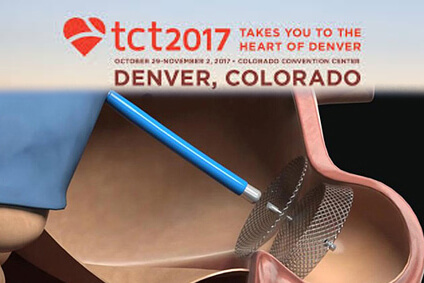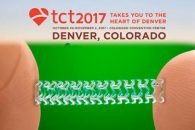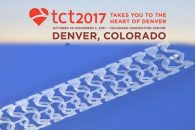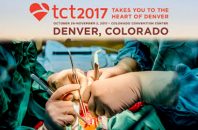Courtesy of SBHCI. The final 5-year outcomes of the PROTECT AF and PREVAIL studies (which assessed the left atrial appendage closure device Watchman) continues to show similar stroke prevention rate to that of warfarin, though with a clear reduction in bleeding. The meta-analysis showed a significant reduction in hemorrhagic stroke (0.17% vs 0.87%), non-procedure related…
TCT 2017 | The TRI-REPAIR and the FORMA Trials: New Devices for the “Forgotten Valve”
Courtesy of SBHCI. Two new transcatheter treatments for severe or massive functional tricuspid regurgitation have showed good results at 30 days, according to their feasibility studies. The long-forgotten tricuspid valve has been gaining more attention with research linking tricuspid regurgitation to an increase in mortality. Early studies used devices originally designed for the mitral or…
TCT 2017 | SENIOR: DES with a Bioresorbable Polymer and Short Dual Antiplatelet Therapy in Elderly Patients
Courtesy of the SBHCI. This study sought to assess the safety and efficacy of an everolimus-eluting stent with a biodegradable polymer (SYNERGY II) vs. a conventional stent (REBEL) in patients >75 years old with short duration of dual antiplatelet therapy. Before randomization, investigators recorded the planned duration of dual antiplatelet therapy (1 month for stable patients and 6 months…
TCT 2017 | REDUCE: 3 vs 12 Months of Dual Antiplatelet Therapy with the New Combo DES
Courtesy of SBHCI. This new device has, on one hand, an abluminal sirolimus coating, and on the other hand, a luminal CD34 antibody coating for EPC capturing, to potentially accelerate post-PCI reendothelization. Between 2014 and 2016, the study included 1496 patients undergoing acute coronary syndrome (ACS), receiving the new COMBO stent. These patients were randomized…
TCT 2017 | INTREPID: Mitral Replacement with a Self-Expanding Device
Courtesy of the SBHCI. Intrepid is a 43-, 46-, and 50-mm nitinol self-expanding valve with bovine pericardial leaflets that is placed using a transapical delivery system with a 35-Fr access. This pilot study enrolled 50 patients with severe mitral regurgitation who were symptomatic and at a high surgical risk, or in whom surgery was contraindicated. Read…
TCT 2017 | MAVERIC: Results 6 Months After Transcatheter Mitral Valve Replacement
Courtesy of the SBHCI. This seems to be the year for transcatheter mitral valve devices, and the ARTO system tested in this study looks promising for the treatment of patients with severe mitral regurgitation who are symptomatic due to heart failure and ejection fraction <40%. The study enrolled 50 patients who underwent clinical and ecocardiographic follow-up…
ABSORB III: after 3 Years, the Bioresorbable Scaffold is Still a Disappointment
Courtesy of the SBHCI. The 3-year outcomes of the ABSORB III trial, which randomized 2008 patients 2:1 to an everolimus eluting bioresorbable scaffold (1322 patients) vs. a metallic stent with permanent everolimus eluting polymer (686 patients), was published with low profile and great disappointment. Primary end-point, a composite of target vessel failure, occurred in 13.4% of patients receiving…
Absorb IV: Bioresorbable Scaffolds with an Optimized Implantation Technique
Courtesy of the SBHCI. The Absorb IV trial randomized 2604 patients in a 1:1 ratio to receive an Absorb everolimus-eluting bioresorbable scaffold or a Xience stent. With the aim of minimizing the problems observed in previous studies, the Absorb IV protocol excluded small caliber (<2.5 mm) vessels and included mandatory aggressive pre-dilation followed by non-complacent balloon post-dilation. Patients could…
ABSORB II: No Benefits from Scaffolds After Complete Bioresorption
Courtesy of the SBHCI. The ABSORB II study sought to assess the mechanical properties of everolimus-eluting bioresorbable scaffolds, such as the increase in minimal lumen area and the recovery of the vasomotor properties of the treated artery. Last year saw the publishing of negative results for the primary endpoints, registering a higher rate of complications at…
DKCRUSH-V: What Is Simple Is Not Always Best for the Left Main Coronary Artery
Courtesy of the SBHCI. Angioplasty of true distal left main bifurcation lesions with a double-kissing (DK) crush two-stent strategy, compared with provisional stenting, results in lower rates of target lesion failure at 1 year. These findings were largely driven by lower rates of target vessel infarction and definite/probable stent thrombosis. Read also: “EXCEL-QOL Substudy: Similar Quality…









